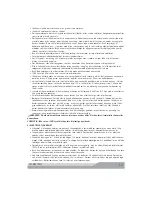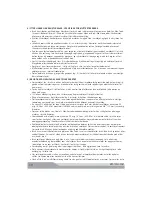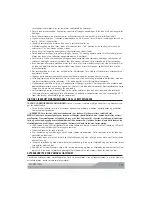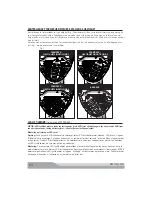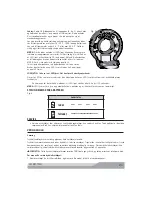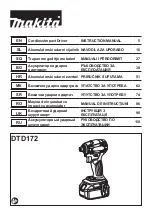
MACTOOLS.COM
6
•
When loosening fasteners fi rst ensure that there is suffi cient clearance behind the tool to avoid hand
entrapment. The tool will move away from the threaded joint as the nut/bolt is loosened and rides up the
thread, moving the tool with it. Make sure hands are kept away from the sockets during tool use.
• Securely fi t the socket or attachment to the impact wrench. Inspect anvil and retaining ring of tool prior to
use. Missing or damaged items should be replaced before use.
• Ensure that the forward/reverse switch is in the correct position for tightening or loosening the fastener.
• The nut/bolt can then run down the thread using the power drive of the tool. For loosening a joint the tool
can be used in the reverse sequence.
• Recommended to use a hardened steel (or material with comparable shock resistance) threaded hose
fi tting (Fig 6).
5) POWER TOOL USE AND CARE
•
Before running the tool, check that there is no dangerous interaction with the immediate environment
(explosive gas, fl ammable or dangerous liquid, unknown piping, electric sheathing or cable, etc).
•
Before connecting the tool to the air inlet, check the trigger is not blocked in the on position by an obstacle.
•
In the event of blockage, release the trigger and disconnect the tool from the compressed air network.
•
Ensure that the unit on which work is being carried out is immobilized.
•
Always operate, inspect and maintain this tool in accordance with all regulations (local, state, federal and
country), that may apply to hand held/hand operated pneumatic tool.
•
For safety, top performance, and maximum durability of parts, operate this tool at 90 psig.
(6.2 bar / 620 kPa) maximum air pressure at the inlet with 3/8’’ (10mm) inside diameter air supply hose.
•
Always use clean, dry air. Dust, corrosive fumes and/or excessive moisture can ruin the motor of an air tool.
• Exceeding the maximum pressure of 90 psig (6.2 bar / 620 kPa) will lead to the risk of danger such as
excessive speed, tool wear, breaking parts, higher torque or force that may destroy the tool and its accesso-
ries or the part being worked on.
•
Maintain power tools. Check for misalignment or binding of moving parts, breakage of parts and any other
condition that may affect the power tool’s operation. If damaged, have the power tool repaired before use.
Many accidents are caused by poorly maintained power tools.
•
Use rated accessories recommended by Mac Tools only. Inspect accessories before use. Do not use crac-
ked or damaged accessories. Just because the accessory can be attached to your power tool, it does not
assure safe operation.
•
Use the power tool, accessories and tool bits, etc. in accordance with these instructions, taking into ac-
count the working conditions and the work to be performed. Use of the power tool for operations different
from those intended could result in a hazardous situation.
• Ensure that sparks and debris resulting from use do not create a hazard.
• The pneumatic tool must be fi tted and connected to the compressed air network via quick disconnects to
facilitate shutdown in the event of danger.
• When the life of the tool has expired, it is recommended that the tool be disassembled, degreased and
parts be separated by material so that they can be recycled.
•
Always turn off the air supply and disconnect the air supply hose before installing, removing or adjusting
any accessory on this tool, or before performing any maintenance on this tool.
•
Do not use damaged, frayed or deteriorated air hoses and fi ttings. Do not abuse hoses or connectors.
•
Do not lubricate tools with fl ammable or volatile liquids such as kerosene, diesel or jet fuel.
•
Do not remove any labels. Periodically inspect labels to ensure all marking are still legible. Replace any
damaged label.
•
Do not use the tool if the trigger does not turn the tool on or off.
• Do not lock, tape or wire the "on/off" trigger in the "on" position, as this trigger must be free to return to
the "off" position when released.
• Be sure all hoses and fi ttings are the correct size and are tightly secured.
•
The use of a hose whip is recommended. A coupler connected directly to the air inlet increases tool bulk
and decreases tool maneuverability.
•
For maximum performance, the coupler on the wall should be the next size larger than the coupler used on
the tool. The coupler closest to the tool should not be less than the proper air supply hose size.

















